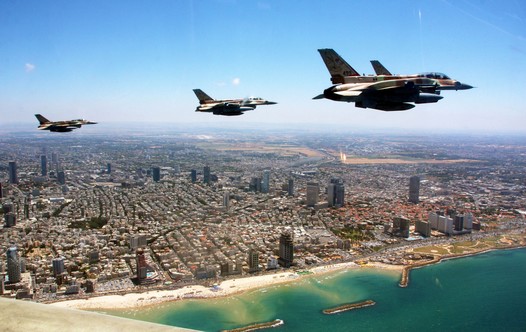Analysis/Israel and Iran Are on a Collision Course in Syria – and the U.S. and Russia Don’t Care
تحليل من الهآرتس بقلم أنشل فيفر: إسرائيل وإيران على مسار تصادمي في سوريا – والولايات المتحدة وروسيا لا يهتمان
Anshel Pfeffer/Haaretz/January 21/19
Sunday’s escalation in Damascus shows what happens when the two global powers’ inaction create a vacuum in the Middle East.
The escalation in the conflict between Israel and Iran in the skies over Syria in the past 24 hours has brought their secret war of the last two years well and truly into the open.
On Sunday, Israel carried out a rare daylight series of airstrikes in the Damascus area, followed by an Iranian attempt to fire a mid-range missile toward northern Israel. Overnight Monday, at 1 A.M., Israel not only launched a second, much wider series of attacks against Iranian targets in Syria, but for the first time announced in real time that they were taking place.
Israel and Iran are now engaged in direct and open conflict in Syria – which is perhaps not so surprising, considering how the events of the last eight years since Syria was plunged into civil war have led to this moment.
What is remarkable is how this latest development is happening without either of the world powers – the United States and Russia – trying to exert any significant influence on the outcome.
In recent years, geopolitical analysts have talked about the world and the Middle East transitioning from an international system where the United States was the only superpower to a more “multipolar” balance. What is happening in Syria now is a nonpolar situation. Neither side, Israel or Iran, seems to want to go all the way to all-out war, but without any restraining hand that could well happen.
Russia pretends to have plans for Syria’s future, but doesn’t seem to be doing much to implement them. The United States, meanwhile, doesn’t even pretend. It is now well into its second White House administration that quite clearly does not consider Syria and the surrounding region important enough for any meaningful U.S. intervention.
On December 19, President Donald Trump ordered a “full” and “rapid” withdrawal of the U.S.’ 2,000 troops from Syria, declaring the Islamic State defeated. Over a month later, it is still unclear how soon “rapid” will be and whether the withdrawal will indeed be “full.”
Since ISIS has obviously not been beaten (though it has lost most of its strongholds and is now a more traditional insurgent movement, without fixed bases) and the United States still claims to be at the forefront of the regional struggle against Iran, there remains the distinct possibility that at least some of the U.S. troops – particularly those near Syria’s border with Iraq – may remain for the time being. But while these will have some tactical, and even strategic, importance, they hardly change the balance of power within Syria.
Two recent ISIS attacks against U.S. forces in Manbij, and the incoherent relationship between the Trump administration and Turkish President Recep Tayyip Erdogan, have placed even more question marks on the administration’s Syria policy, if it even has one.
Last year, Russia promised to keep Iranian forces at least 60 kilometers (nearly 40 miles) away from Israel’s border. It also said it would greatly upgrade Syria’s anti-aircraft capabilities and, through its various media patsies, darkly warned of reining in Israeli attacks.
In reality, none of this has happened. Nothing Russia has said or done in recent months has had any real effect on the ground.
Russian military police have occasionally been deployed to checkpoints on the Golan Heights, but they haven’t prevented Iran from establishing outposts overlooking Israeli positions. Neither has Russia done anything to remove the base south of Damascus where Iran is currently stationing thousands of its Fatemiyoun battalions (Shi’ite mercenaries from Afghanistan, Pakistan and Iraq).
Russia may have shipped new surface-to-air missile batteries to Syria, but it hasn’t resulted in a noticeable upgrade – certainly not enough to hinder Israeli airstrikes, which continue unabated despite Moscow’s obvious displeasure.
Russia’s apparent ineffectiveness should not be surprising. The Kremlin wants to give the impression that it controls events in Syria. But the truth is that it has only two real objectives there: Safeguarding the Assad regime; and establishing its own air base and port on Syria’s Mediterranean coast. It has achieved both of these at relatively little cost – the deployment of less than 30 aircraft and a couple of battalions of ground troops.
Curtailing either Iran or Israel’s operations in Syria would necessitate way more diplomatic and military resources than Russia is prepared to invest. It is clear now that the most Israel can expect from its own engagement with the Russian leadership is “deconfliction” – ensuring there is no direct clash between the two countries’ aircraft in the skies above Syria. But that’s about all.
The bottom line is that Syria remains as it was from the beginning of the civil war in 2011. Neither the Assad regime nor any of the external players can (or want to) control it outright. Russia wants bases and the United States just wants to get the hell out; Turkey is interested in controlling various northern regions and suppressing the Kurdish population; Iran is interested in a beachhead that will serve as a link in its Shia crescent, encompassing Iraq and Lebanon as well; Israel will do almost anything to stymie Iran’s plan.
With the global powers effectively leaving a vacuum in Syria, Israel and Iran are increasingly on a collision course no one is trying to prevent. This is what a region the world powers have left to its own devices looks like.




















